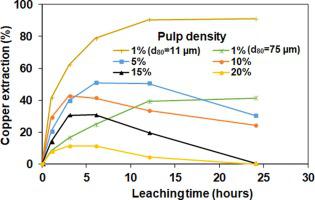当前位置:
X-MOL 学术
›
Miner. Eng.
›
论文详情
Our official English website, www.x-mol.net, welcomes your
feedback! (Note: you will need to create a separate account there.)
Glycine leaching of Sarcheshmeh chalcopyrite concentrate at high pulp densities in a stirred tank reactor
Minerals Engineering ( IF 4.9 ) Pub Date : 2020-10-01 , DOI: 10.1016/j.mineng.2020.106555 Maryam Khezri , Bahram Rezai , Ali Akbar Abdollahzadeh , Mehdi Molaeinasab , Benjamin P. Wilson , Mari Lundström
Minerals Engineering ( IF 4.9 ) Pub Date : 2020-10-01 , DOI: 10.1016/j.mineng.2020.106555 Maryam Khezri , Bahram Rezai , Ali Akbar Abdollahzadeh , Mehdi Molaeinasab , Benjamin P. Wilson , Mari Lundström

|
Abstract The simplest amino acid, glycine has recently been reported as a safe and environmentally benign reagent for the extraction of copper from both oxide and sulfide minerals. In the current study, leaching of a chalcopyrite concentrate from the Sarcheshmeh Copper Mine (Kerman, Iran) was conducted in stirred tank reactors in the presence of a glycine medium. The effect of some critical leaching parameters including glycine concentration (0.4–2 M), temperature (30–90 °C), stirring rate (250–750 rpm), pH (9–12), oxygen flowrate (0.5–2 L/min) and pulp density (1–20%) was investigated on copper recovery from the chalcopyrite concentrate. Results show that an increase in temperature from 30 to 60 ˚C enhanced the copper extraction, whereas at conditions > 60 ˚C a decrease in copper extraction was observed, probably as a result of the conversion of glycine to glycinate and decrease in oxygen solubility. Moreover, prolonged leaching times at higher pH levels (10.5 and 12) led to a decrease in the extraction of copper, primarily due to the chemical precipitation of copper sulfide and crystallization of copper glycinate. By increasing the pulp density from 1 to 20%, copper extraction declined significantly primarily as a consequence of the partial dissolved copper precipitation at higher copper concentrations. SEM/WDX analyses were subsequently used in order to evaluate the leach residues. Further investigation determined that the activation energy of the glycine leaching of concentrate was 37.4 KJ/mol, thus the kinetics were controlled by diffusion of the reagents through the product layer. From these results, it is evident that due to the high initial rate of glycine leaching and the precipitation of copper-bearing phases (i.e. copper glycinate and covellite) at high pulp densities, glycine leaching processes are recommended for the treatment of low grade chalcopyrite concentrates, ores or tailings.
中文翻译:

在搅拌釜反应器中以高纸浆密度对 Sarcheshmeh 黄铜矿精矿进行甘氨酸浸出
摘要 最近,最简单的氨基酸甘氨酸被报道为一种安全且环境友好的试剂,用于从氧化物和硫化物矿物中提取铜。在目前的研究中,在甘氨酸介质存在的情况下,在搅拌釜反应器中对来自 Sarcheshmeh 铜矿(伊朗克尔曼)的黄铜矿精矿进行浸出。一些关键浸出参数的影响,包括甘氨酸浓度 (0.4–2 M)、温度 (30–90 °C)、搅拌速率 (250–750 rpm)、pH (9–12)、氧气流量 (0.5–2 L/ min) 和矿浆密度 (1–20%) 研究了从黄铜矿精矿中回收铜的情况。结果表明,温度从 30 ˚C 增加到 60 ˚C 会增强铜提取,而在 > 60 ˚C 的条件下,观察到铜提取减少,可能是甘氨酸转化为甘氨酸和氧溶解度降低的结果。此外,在较高 pH 值(10.5 和 12)下延长浸出时间会导致铜的提取减少,这主要是由于硫化铜的化学沉淀和甘氨酸铜的结晶。通过将纸浆密度从 1% 增加到 20%,铜提取量显着下降,这主要是由于在较高铜浓度下部分溶解的铜沉淀。随后使用 SEM/WDX 分析来评估浸出残留物。进一步研究确定,精矿甘氨酸浸出的活化能为 37.4 KJ/mol,因此动力学受试剂通过产物层的扩散控制。从这些结果来看,
更新日期:2020-10-01
中文翻译:

在搅拌釜反应器中以高纸浆密度对 Sarcheshmeh 黄铜矿精矿进行甘氨酸浸出
摘要 最近,最简单的氨基酸甘氨酸被报道为一种安全且环境友好的试剂,用于从氧化物和硫化物矿物中提取铜。在目前的研究中,在甘氨酸介质存在的情况下,在搅拌釜反应器中对来自 Sarcheshmeh 铜矿(伊朗克尔曼)的黄铜矿精矿进行浸出。一些关键浸出参数的影响,包括甘氨酸浓度 (0.4–2 M)、温度 (30–90 °C)、搅拌速率 (250–750 rpm)、pH (9–12)、氧气流量 (0.5–2 L/ min) 和矿浆密度 (1–20%) 研究了从黄铜矿精矿中回收铜的情况。结果表明,温度从 30 ˚C 增加到 60 ˚C 会增强铜提取,而在 > 60 ˚C 的条件下,观察到铜提取减少,可能是甘氨酸转化为甘氨酸和氧溶解度降低的结果。此外,在较高 pH 值(10.5 和 12)下延长浸出时间会导致铜的提取减少,这主要是由于硫化铜的化学沉淀和甘氨酸铜的结晶。通过将纸浆密度从 1% 增加到 20%,铜提取量显着下降,这主要是由于在较高铜浓度下部分溶解的铜沉淀。随后使用 SEM/WDX 分析来评估浸出残留物。进一步研究确定,精矿甘氨酸浸出的活化能为 37.4 KJ/mol,因此动力学受试剂通过产物层的扩散控制。从这些结果来看,











































 京公网安备 11010802027423号
京公网安备 11010802027423号